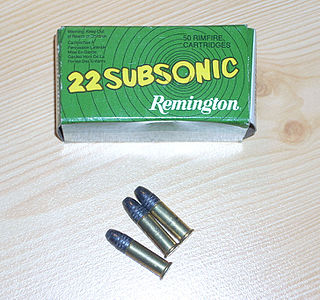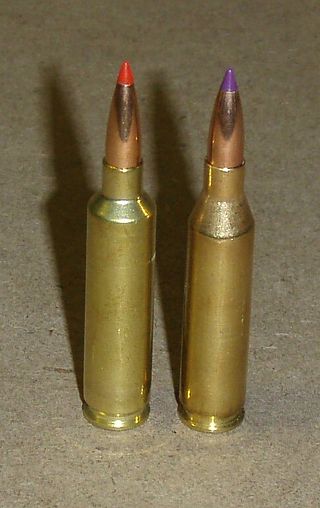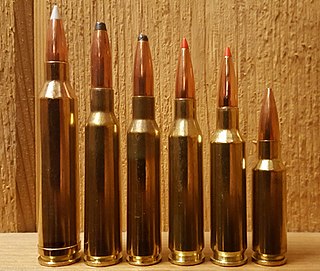
The .22 Long Rifle, also known as the .22LR or 5.6×15mmR, is a long-established variety of .22 caliber rimfire ammunition originating from the United States. It is used in a wide range of firearms including rifles, pistols, revolvers, and submachine guns.

The .223 Remington is a rimless, bottlenecked, centerfire intermediate cartridge. It was developed in 1957 by Remington Arms and Fairchild Industries for the U.S. Continental Army Command of the United States Army as part of a project to create a small-caliber, high-velocity firearm. The .223 Remington is considered one of the most popular common-use cartridges and is used by a wide range of semi-automatic and manual-action rifles.

The 7.62×25mm Tokarev cartridge is a Soviet rimless bottleneck pistol cartridge widely used in former Soviet states and in China, among other countries. The cartridge has since been replaced in most capacities by the 9×18mm Makarov in Russian service.

Subsonic ammunitions are ammunitions designed to operate at velocities below the speed of sound, which at standard conditions is 340.29 m/s (1,116.4 ft/s). This avoids the supersonic shockwave or "crack" of a supersonic bullet, which, particularly for suppressed firearms, influences the loudness of the shot.

A wildcat cartridge, often shortened to wildcat, is a custom-made cartridge for which ammunition and/or firearms are not mass-produced. These cartridges are often created as experimental variants to optimize a certain ballistic performance characteristic of an existing commercial cartridge, or may merely be intended as novelty items.
The .338 Whisper (8.59x38mm) is a wildcat cartridge in the Whisper family, a group of cartridges developed in the early 1990s by J.D. Jones of SSK Industries. Unlike the smaller caliber cartridges in the Whisper family, loads for the .338 Whisper are mainly limited to subsonic velocities.

The 6mm PPC, or 6x38 PPC as it is more often called, is a centerfire rifle cartridge used almost exclusively for benchrest shooting. It is one of the most accurate cartridges available at distances of up to 300 meters. This cartridge's accuracy is produced by a combination of its stout posture, being only 31 mm (1.22 in) long, and aggressive shoulder angle of 30 degrees. Its primary use has been benchrest shooting matches since the 1980s.
The Whisper family of firearm cartridges is a group of wildcat cartridges developed in the early 1990s by J.D. Jones at SSK Industries. The Whisper family was developed as a line of accurate, multi-purpose cartridges using relatively heavy rifle bullets for a given caliber in subsonic loads. The intention was to create an extremely accurate cartridge family for military, police, competition and specialized hunting markets that could also be easily sound suppressed.

The .222 Remington or 5.7×43mm (C.I.P), also known as the triple deuce, triple two, and treble two, is a centerfire rifle cartridge. Introduced in 1950, it was the first commercial rimless .22 (5.56 mm) cartridge made in the United States. As such, it was an entirely new design, without a parent case. The .222 Remington was a popular target cartridge from its introduction until the mid-1970s and still enjoys a reputation for accuracy. It remains a popular vermin or "varmint" cartridge at short and medium ranges with preferred bullet weights of 40–55 grains and muzzle velocities from 3,000 to 3,500 ft/s (915–1,067 m/s).

The .458 SOCOM (11.63×40mmRB) is a moderately large round designed to work in an AR-15 platform. This is achieved by installing a 458 bolt and barrel. The 300-grain (19 g) round offers a supersonic muzzle velocity of 1,900 ft/s (580 m/s) and 2,405 ft⋅lbf (3,261 J), similar to a light .45-70 but with a much smaller case.

.22 caliber, or 5.6 mm, refers to a common firearms bore diameter of 0.22 inch (5.6 mm) in both rimfire and centerfire cartridges.

The 6.5mm Creedmoor (6.5×48mm), designated 6.5 Creedmoor by SAAMI, 6,5 Creedmoor by the C.I.P. is a centerfire rifle cartridge introduced by Hornady in 2007. It was developed by Hornady senior ballistics scientist Dave Emary in partnership with Dennis DeMille, the vice-president of product development at Creedmoor Sports, hence the name. The cartridge is a necked-down modification of the .30 Thompson Center.

The .300 AAC Blackout, also known as 7.62×35 mm, is an intermediate cartridge developed in the United States by Advanced Armament Corporation (AAC) for use in the M4 carbine. The cartridge yields increased performance in shorter barrels and effective subsonic performance for silencer use when compared to 5.56 mm NATO. The .300 AAC Blackout uses standard 5.56 mm NATO magazines and components with the exception of the barrel.

A varmint rifle is a small-caliber precision firearm or high-powered airgun primarily used for both varmint hunting and pest control. These tasks include killing three types of pests or nuisance animals that spread diseases or destroy crops or livestock:

The 7.62×40mm Wilson Tactical is a centerfire rifle cartridge introduced in 2011 by Wilson Combat. The goal was to produce an accurate, low-recoil .30-caliber hunting cartridge that could be used in an AR-15-type rifle using as many standard components as possible.

The 7.62×39mm round is a rimless bottlenecked intermediate cartridge of Soviet origin. The cartridge is widely used due to the global proliferation of the AK-47 rifle and related Kalashnikov rifles, as well as the SKS, RPD, and RPK light machine guns.

The 7.62×37mm Musang is an assault rifle cartridge introduced in 2012 developed and manufactured in the Philippines by the Government Arsenal for use by the military in special operations and close quarter battle.
The .277 Wolverine (6.8x39mm) is a wildcat cartridge. It is a multi-purpose mid-power cartridge with increased ballistic performance over the AR-15's traditional .223 Remington cartridge. The use of a modified 5.56 case means that at minimum, only a new barrel is needed to convert any 5.56-based firearm to .277 Wolverine.

8.6mm Blackout, also sometimes referred to as 8.6 BLK, is a centerfire rifle cartridge developed by the firearms manufacturer Q, LLC. It utilizes a shortened case from the 6.5mm Creedmoor necked up to an 8.6 mm caliber projectile. 8.6 Blackout is designed for use in bolt-action rifles or as a caliber conversion for AR-10 style rifles.
















